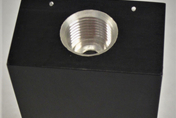Valence Seattle Adds Capability for Black Dye Anodizing
Valence Seattle has added capability for Type II and Type III Anodizing with Class 2 black dye, further expanding its offerings after launching Type III Anodizing operations in September 2020.
#military #aerospace
Edited by Evan Doran

Valence Seattle (Seattle, Wash.) has further expanded its anodizing services for the aerospace and defense supply chain. The company now offers Type II and Type III Anodizing with Class 2 black dye, which it says enhances its ability to provide a single-supplier solution for aerospace outside processing in the Pacific Northwest. This new capability compliments Valence Seattle’s addition of Hard (Type III) Anodizing services, which it began offering after completing its facility expansion in September 2020.
“Hard Anodize (Type III) in Seattle is a game-changer for the region,” says Jim Duncan, Valence Seattle QA manager. “Adding black dye as well further expands our capabilities to support our customers’ growing needs for this and other processes.”
Valence Seattle’s 32,000-square-foot-facility is located in the heart of Washington’s aerospace hub and offers full-service NDT (penetrant and magnetic particle inspection), aluminum and hard metal chemical processing, shot peen and paint services. Valence Seattle has two process lines for titanium, steel and aluminum processing — these lines can carry out chemfilm, Type I, Type II and Type III Anodize operations.
RELATED CONTENT
-
Andrews Powder Coating Earns Space Flight Qualification
The first-tier aerospace powder coating supplier recently had its MIL-SPEC powder coatings qualified for coating power supplies for a classified military satellite program.
-
Electrodeposition of Nanocrystalline Cobalt-Phosphorus Coatings as a Hard Chromium Alternative for Use in DoD Acquisition Programs
Electrolytic hard chromium plating (EHC) is a critical surface finishing technology that is used for applying functional coatings for corrosion and wear resistance to aircraft components in manufacturing operations and for re-build of worn or corroded components. However, EHC plating baths contain hexavalent chromium, which is a known carcinogen and environmental hazard. Therefore, the replacement of EHC in aircraft manufacturing activities and maintenance depots is a high priority for the U.S. Department of Defense (DoD).
-
Development of Life Prediction Models for High Strength Steel in a Hydrogen Emitting Environment
Solvent substitution for maintenance and overhaul operations of military systems has been a primary environmental concern for many years. Cadmium replacement in these systems has been targeted for decades. Both of these areas have a common obstacle for implementation of any potential alternate. Hydrogen embrittlement of high strength steel is the most predominant unforeseen hurdle since high strength materials show sensitivity to the phenomena and the source of the hydrogen can be anything within the fabrication process, maintenance practice or the natural corrosion cycle. Standardized testing on this issue has traditionally stemmed from the aerospace industry where it is a principal focus.
















